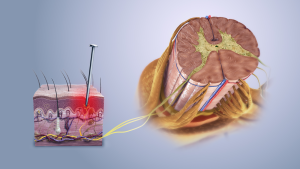Somatosensation
17 Categories of Pain
Learning Objectives
Be able to define nociceptive pain and give an example.
Be able to define inflammatory pain and give an example.
Be able to define neuropathic pain and give an example.
There are three types of pain.
Nociceptive pain is mediated by cutaneous receptors which detect heat, cold, severe force and chemical insult.
- Medical term that describes pain from physical or potential damage to the body
- Examples: pain felt from sports injuries, dental procedures, or arthritis
Inflammatory pain happens when immune responses activate nociceptors in response to injury. Pain associated with tumors and post-injury swelling are examples of inflammatory pain.
- An increased sensitivity due to an immune inflammatory response
- Examples: pain, redness, or swelling caused by a cut, bump, and any injuries ranging from minor to major
Neuropathic pain is caused by damage to the nervous system itself (e.g. carpal tunnel syndrome, sciatic nerve pain).
- Associated with abnormal sensations or pain from non-painful stimuli
- Examples: phantom limb, neuralgia, diabetic neuropathy, central pain syndrome


CC LICENSED CONTENT, SHARED PREVIOUSLY
Cheryl Olman PSY 3031 Detailed Outline
Provided by: University of Minnesota
Download for free at http://vision.psych.umn.edu/users/caolman/courses/PSY3031/
License of original source: CC Attribution 4.0
Adapted by: Annie Chen

